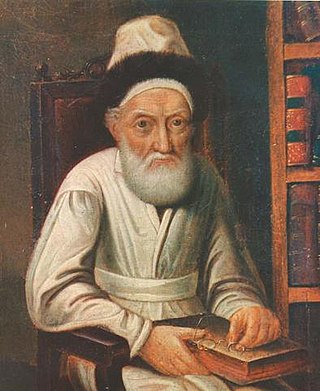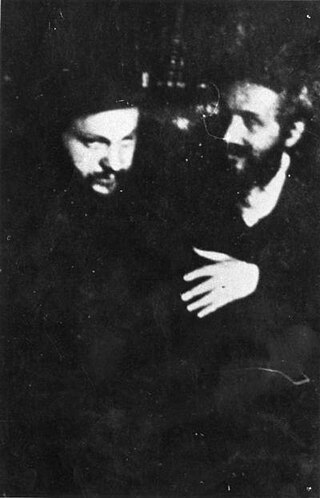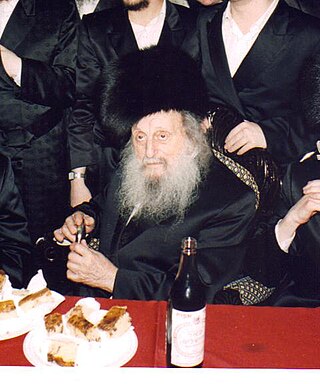
Menachem Mendel Schneersohn also known as the Tzemach Tzedek was an Orthodox rabbi, leading 19th-century posek, and the third rebbe of the Chabad Lubavitch Hasidic movement.

Ger is a Polish Hasidic dynasty originating from the town of Góra Kalwaria, Poland, where it was founded by Yitzchak Meir Alter (1798–1866), known as the "Chiddushei HaRim". Ger is a branch of Peshischa Hasidism, as Yitzchak Meir Alter was a leading disciple of Simcha Bunim of Peshischa (1765–1827). Before the Holocaust, followers of Ger were estimated to number in excess of 100,000, making it the largest and most influential Hasidic group in Poland. Today, the movement is based in Jerusalem, and its membership is estimated at 11,859 families, as of 2016, most of whom live in Israel, making Ger the largest Hasidic dynasty in Israel. However, there are also well-established Ger communities in the United States and in Europe. In 2019, some 300 families of followers led by Shaul Alter, split off from the dynasty led by his cousin Yaakov Aryeh Alter.
In Jewish law and history, Acharonim are the leading rabbis and poskim living from roughly the 16th century to the present, and more specifically since the writing of the Shulchan Aruch in 1563 CE.
Shotz is a Hasidic dynasty originating in the city of Suceava, Romania.

Chernobyl is a Hasidic dynasty which was founded by Grand Rabbi Menachem Nachum Twersky, known by his work as the Meor Einayim. The dynasty is named after the northern Ukrainian city of Chernobyl, where Rabbi Nachum was the maggid. The lineage continues to exist, although not always with the name Chernobyl. Several rebbes are named Chernobyl. The central court is in Bnei Brak, headed by Rabbi Menachem Nachum Twersky.

Biala is a Hasidic dynasty originating from the city of Biała Rawska, where it was founded by R. Yaakov Yitzchak Rabinowicz (II). Biala is a branch of Peshischa Hasidism, as R. Yaakov Yitzchak Rabinowicz (II) was the great-grandson of R. Yaakov Yitzchak Rabinowicz, the first Peshischa Rebbe. The dynasty was originally spread throughout many towns in Poland, often taking the names of said towns. However, after the Holocaust, the name "Biala" become synonymous with the entire dynasty. Today the dynasty is mostly concentrated in Israel, America and Switzerland.

Akiva Eiger, or Akiva Güns was a Talmudic scholar, halakhic decisor and leader of European Jewry during the early 19th century.

Moetzes Gedolei HaTorah is the supreme rabbinical policy-making council of the Agudat Yisrael and Degel HaTorah movements in Israel; and of Agudath Israel of America in the United States. Members are usually prestigious Roshei Yeshiva or Hasidic rebbes, who are also usually regarded by many Haredi Jews to be the Gedolim ("great/est") sages of Torah Judaism. Before the Holocaust, it was the supreme authority for the World Agudath Israel in Europe.
The Novardok Yeshiva was one of the largest and most important yeshivas in pre-World War II Europe, and a force within the Mussar movement. It was the first of hundreds of a network of Musar yeshivas that were all called Novardok yeshivas.
Mordechai Yosef Leiner of Izbica known as "the Ishbitzer" (1801-1854) was a rabbinic Hasidic thinker and founder of the Izhbitza-Radzyn dynasty of Hasidic Judaism. He is best known for his work Mei Hashiloach.
Rabbi Zadok ha-Kohen Rabinowitz of Lublin, or Tzadok Hakohen or Tzadok of Lublin, was a significant Jewish thinker and Hasidic leader.

Yehuda Leib "Leibel" Groner was an American Hasidic Jewish teacher, scholar, and author. He is best known for having served as the personal secretary to Rabbi Menachem Mendel Schneerson, the seventh Lubavitcher Rebbe, for 40 years.

Ashlag is the name of a number of Hasidic courts that were established in Israel by the students and descendants of Kabbalist Rebbe Yehuda Leib Haleivi Ashlag from Warsaw, Poland, known as Baal HaSulam.

Izhbitza-Radzin is a dynasty of Hasidic rebbes. The first rebbe was Rabbi Mordechai Yosef Leiner from Izbica, author of Mei Hashiloach who left the court of Rabbi Menachem Mendel of Kotzk to found his own Hasidic movement in 1839.

Grand Rabbi Shmuel Shlomo Leiner (1909–1942) was the Radziner Rebbe.

Grand Rabbi Avraham Yissochor Englard of Radzin, was a scion of Radomsk and the Chief Rabbi of Sosnowiec.
Dinov is the name of a Hasidic dynasty, descended from Rabbi Tzvi Elimelech Spira of Dinov, also called "the Bnei Yisaschar" after his popular work: בני יששכר [Bene Yiśaśkhar]. Dinov is the Yiddish name of Dynów, a town in southern Poland, in the historic region of Galicia.
Rabbi Solomon Eger was an influential rabbi and successor of his father as the rabbi of Posen, then in Germany.
Hasidic Judaism in Poland is the history of Hasidic Judaism and Hasidic philosophy in Poland. Hasidic Judaism in Poland began with Elimelech Weisblum of Lizhensk (Leżajsk) (1717-1787) and to a lesser extent Shmelke Horowitz of Nikolsburg (Mikulov) (1726-1778). Both men were leading disciples of Dov Ber of Mezeritch (Medzhybizh), who in part was the successor to the Baal Shem Tov who founded Hasidic Judaism in Western Ukraine. Today, a sizable portion of contemporary Hasidic Judaism and Hasidic dynasties trace their genealogical and ideological origin to Polish Hasidism.
Rabbi Kalman Meir Ber is the Ashkenazi Chief Rabbi of Israel and President of the Chief Rabbinate Council. Previously, he served as the rabbi of Netanya and as the rabbi of the Kerem Yeshiva in Yavne, among other positions.










